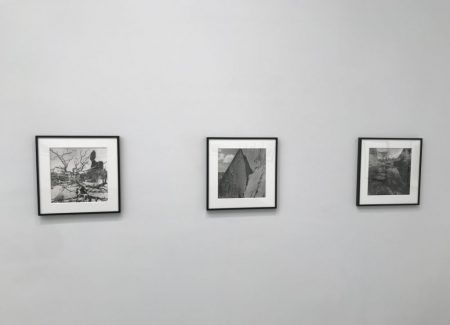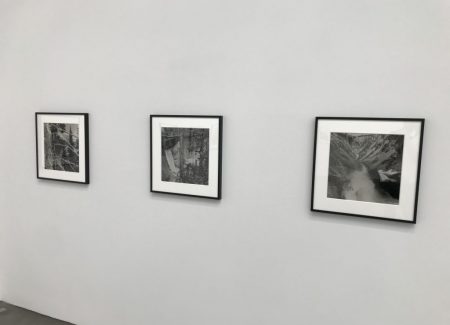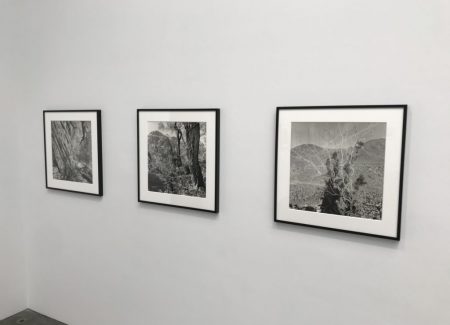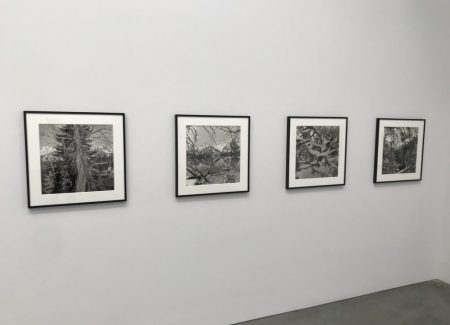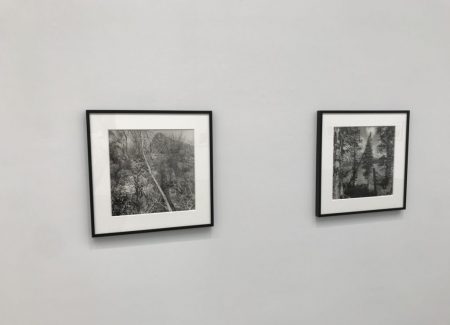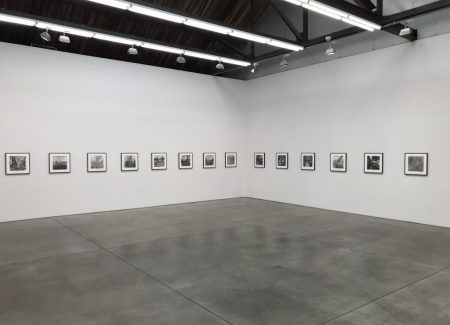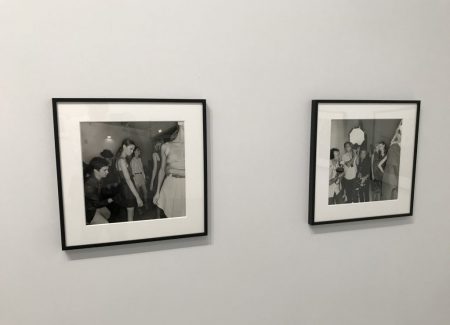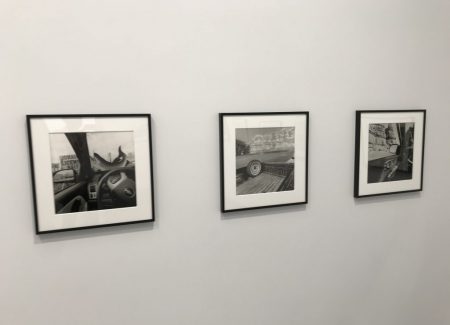JTF (just the facts): A total of 54 black and white photographs, framed in black and matted, and hung against white walls in the main gallery space, the smaller back gallery, and the entrance area. All of the works are gelatin silver prints, made between 1966 and 2012, and in many cases printed later. Most of the images are square format, and printed in sizes of roughly 15×15 or 19×19 inches; just 3 prints are sized differently (all from earlier in the artist’s career), at roughly 12×19 inches. None of the works are editioned. (Installation shots below.)
Comments/Context: In the past decade, Lee Friedlander has had shows in New York at no less than six different galleries. He was represented by Janet Borden, did a one off show with Mary Boone, jumped to Pace/MacGill and Pace, has done other one off shows with Deborah Bell, and has now landed at Luhring Augustine. While his primary relationship with Fraenkel Gallery in San Francisco has stayed steady through the years, it’s been a whirlwind of movement here.
One challenge that comes with all of this shuffling is that a coherent long term curatorial and exhibition plan keeps getting restarted. Every time there is a change in his New York representation, the new gallery needs to start over and introduce Friedlander to their collector base, thereby using precious exhibition slots for high level surveys or greatest hits gatherings. The one off shows happily bring lesser known and underappreciated bodies of work out for rediscovery, but by definition, they aren’t part of larger systematic effort. For an artist in his mid-80s, this isn’t something to discount. Friedlander is important enough to merit a lengthy future plan that not only keeps his original eye in the artistic mix but methodically deepens our understanding of his prolific career. All this bouncing around is wasting precious time, and to some extent, diluting his potential influence.
This show at Luhring Augustine uses Friedlander’s cluster of recent photobook publications as the framework for an introductory survey. The majority of the show centers on Western Landscapes (2016), but the back room takes a quick pass through America by Car (2010), New York Fashion Week (2015), and Chain Link (2017), providing a sampler of Friedlander’s range and ingenuity.
In many ways, it’s easy to see Friedlander’s newer landscapes as a direct aesthetic extension from those he made in The Desert Seen (1996) and Recent Western Landscape (2008). In those pictures, Friedlander overtly broke with the long-standing traditions of American landscape photography, not only eschewing the majestic grandeur and romance of the land, but deliberately frustrating our ability to see them with a constant barrage of foreground interruptions and eye-poking intrusions. That he did all this while still finding a way to make photographs that were sublimely elegant was where the magic lay – somehow he was brashly upending everything we took for granted about what a beautiful photographic landscape looked like, in a way that almost felt like he was laughing at us, but still, those very same photographs were consistently crisply-crafted and beautiful in their own way.
For the most part, Friedlander applies the same formula in this latest round of landscapes. Hitting the road, he makes a grand tour of some of North America’s most dramatic natural wonders and parklands – Yosemite, Yellowstone, Arches, Grand Teton, Zion, Death Valley, Glacier, Jasper, Big Bend, Monument Valley, Point Lobos, Lake Louise, Mount Rainier, even the Grand Canyon. And at every stop, he essentially makes the same picture – he finds the most awe-inspiring, postcard-ready view of the mountains, the lake, the rocks, the canyon, or whatever, and then proceeds to break up or reorient that view with something in the foreground. Craggy gnarled trees make the best disruptors (especially since they were so often celebrated by the previous generation of American landscape photographers), but Friedlander makes do with all kinds of available natural resources – up close tree bark, underbrush, cacti, hanging evergreen branches, lakeside rocks and boulders (seen from a low angle), basically anything scratchy, poky, or vertically jolting that can be arranged into a position of controlled conflict with the vista behind it.
That Friedlander is so consistently successful is a testament to his skill as a photographer – we know the game he’s playing and he surprises and astonishes us nonetheless. A young photo student who was circling the gallery when I visited repeatedly filled the space with his quietly amused chuckling, which I took as a sign of both admiration and respect – many of the pictures can absolutely be seen as irreverently funny, for those who appreciate the artist’s wry sense of visual humor. Friedlander blocks treasure after natural treasure, always showing us something different than we expected. He blocks the towering ridgeline of the Grand Tetons with three vertical trees and again with a dry evergreen; he encourages grasping branches to screen the Grand Canyon; he blocks Half Dome in Yosemite with a dripping limb; he forces us to look at the dry desert beneath our feet instead of the sinuous mesas in Monument Valley in the distance; and he looks down over a frothy waterfall in Yellowstone rather than show us its typical cascading form. Again and again, he inverts the position of central attention, giving us something else to keenly observe nearby rather than the visual cliché over yonder.
In the back room, these compositional inversions take similar form using alternate subject matter, going all the way back to the 1960s. Friedlander uses chain link fencing as a transparent frontal screen, dividing space, creating angles, and interrupting our view of everything from alligators and humping rhinos to clusters of fan shaped palms. He uses the edge of various rental cars, as well as the side and rear view mirrors, to cleverly rearrange and multiply American road trip sights. And during New York Fashion Week, he mostly points his camera at the bustling chaos surrounding the models rather than at the models themselves, capturing hordes of hairdressers and photographers swirling around. In each case, he’s smartly managing the space inside the frame, rethinking what we should be looking at and seeing.
The problem with this show isn’t that the talent on display is somehow lacking – on the contrary, Friedlander’s compositional prowess can gracefully upend almost any subject. It’s more that this show doesn’t teach us much we don’t already know – either we’ve seen the works before in other contexts, or we might as well have, as they travel on paths we’ve walked with him previously. As Friedlander ages, what we need from his galleries is either freshly made work, to the extent it is intriguing (2012 doesn’t count as recent), or a systematic, confident, and definitive resynthesis of different portions of his long career. This show isn’t really either of those things, and so however masterfully made many of the pictures here are, it feels a bit like a missed opportunity.
Collector’s POV: The prints in this show are priced at $12500 or $16000, based on size. Friedlander’s work is routinely available in the secondary markets, with recent prices at auction ranging from roughly $2000 on the low end to as much as $80000 for his most iconic vintage prints. In 2015, a selection of Friedlander’s little screens (38 prints in all) sold for $850000.

